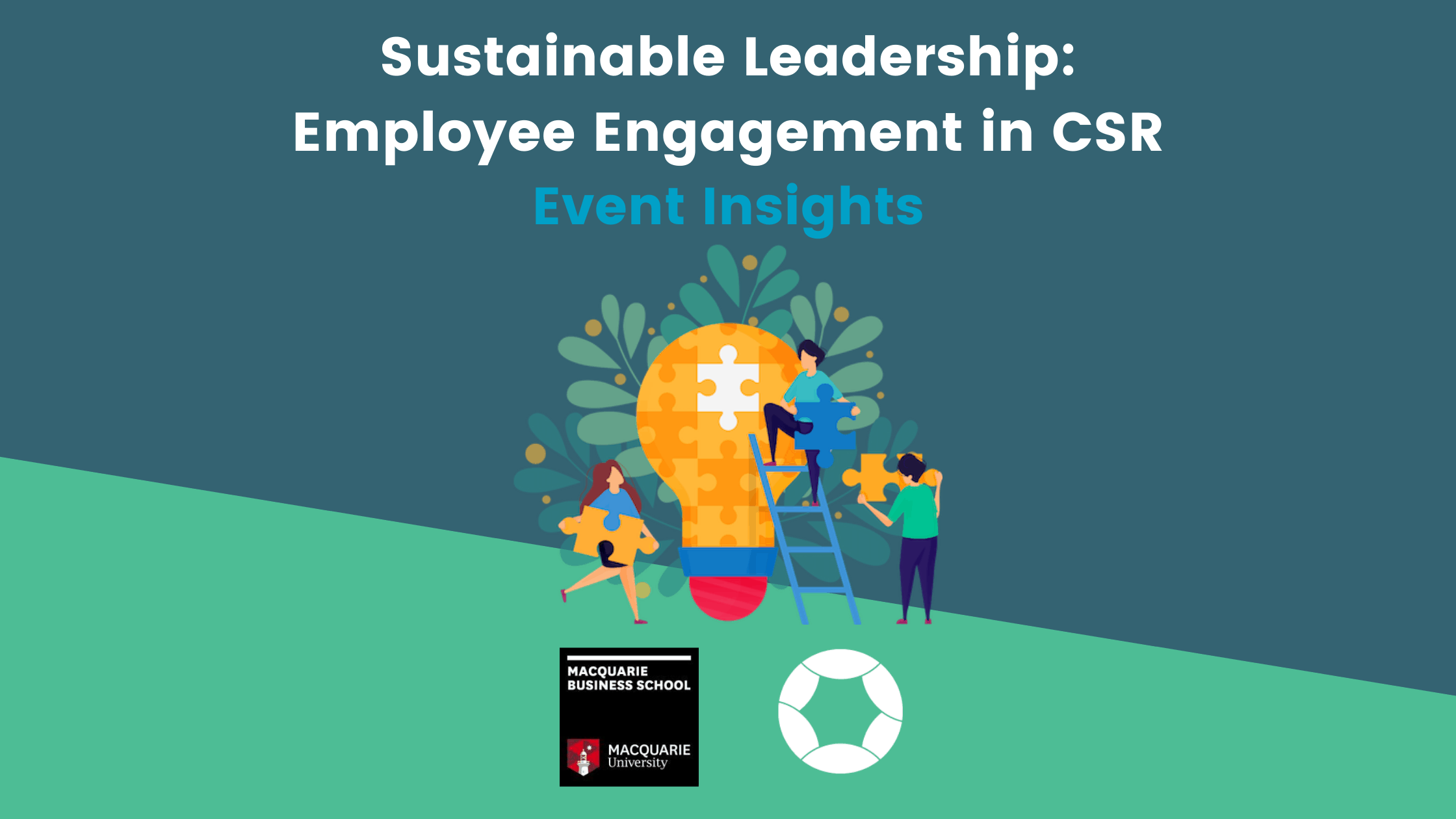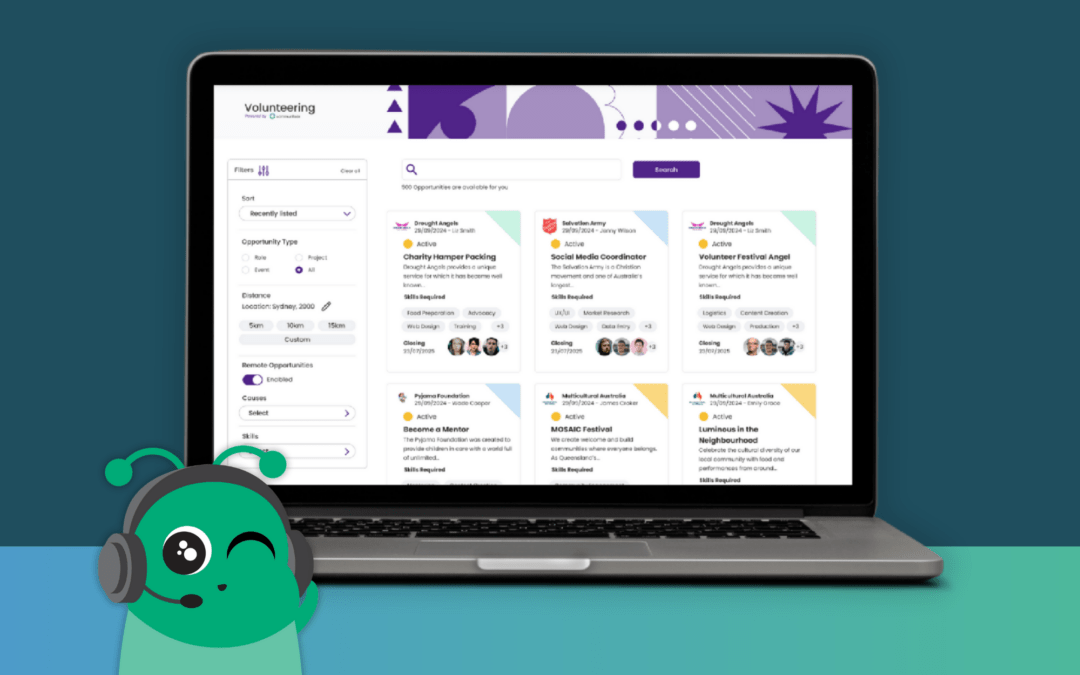For our second event of the series, Employee Engagement in CSR (corporate social responsibility), we had the opportunity to hear from our expert panellists:
Helen Maisano, Director of Optus Sustainability at Optus
Frances Martin ,VP Operations and Enablement at Optus
Nina Mapson Bone, Managing Director at Beaumont People
Prof Debbie Haski-Leventhal, Professor in the Department of Management at Macquarie Business School
In our Sustainable Leadership series, we are sharing stories and case studies of how the worlds of For-Profit and For-Purpose have been combined to motivate, engage, and mobilise corporate teams.
Here are a few learnings about employee engagement in CSR:
1. The statistics show employees are disengaged, and focussing on purpose can change that
Debbie shares some grim stats with the audience:
- Employee engagement today:
- 1/5 employees are actively disengaged. This means people don’t want to be at work.
- Volunteering is a great way for employee engagement in CSR
- The Business Case for Purpose (from Harvard Business Review, sponsored by EY) found:
- 94% strongly believe a clear purpose important for strategic transformation
- 92% strongly believe a clear purpose is a guide for innovation
- 86% strongly believe companies perform best if there’s purpose over profit
- 86% strongly believe today’s business focus should be on developing purpose
2. There are multiple benefits of focussing on purpose
- Society
- To create change & social impact
- Organisation
- Brand reputation
- Performance
- Destination of choice
- People
- Engagement
- Shared narrative
- Affiliation & pride
3. Not all CSR programs are created equal
According to Debbie, CSR requires “a holistic and long-term approach to the broad responsibilities of business, based on stakeholder integration and ethical behaviour, while utilising the firm’s resources and brand to address societal and environmental issues.”
There are 6 main elements of CSR:
- Holistic
- Long-term
- Brand responsiilities
- Stakeholder integration
- Ethical behaviour
- Utilising firm’s resources & brand
4. Employee engagement in CSR lifts overall engagement
Some examples are given to illustrate the point:
- CSR creates a sense of purpose & pride, which increases employee engagement
- Employee engagement in CSR leads to integration, involvement & leadership
- There’s been a transition in what CSR looks like. Traditionally, CSR meant payroll giving and corporate volunteering. Now, CSR comes in the forms of social intrapreneurship, activism, and employee-led action.
5. Give people options to get involved
According to Helen, setting structures and providing flexibility is important to ensure that people want to engage in CSR. “People have preferences and need space to explore them”, so it’s your responsibility to understand their skills, knowledge, and experiences and try to leverage them into your CSR programs.
Nina also recognises the importance of connecting the dots: “where you can tie the skills you have to the impact it can make, that’s where we have seen a much greater uptake.”
And, as we expect, Frances also echoes this sentiment: “When you work in a big organisation, there’s a range of interests, skills and resources – a one-size-fits-all CSR program doesn’t work!”
6. Integrate the community into every facet of the organisation
There should be feel-good aspects for everyone, which creates greater engagement for all (even if there is a work element in it).
One way of doing this, Frances recommends, is to donate your data so that customers can participate in some of these programs. For VP Operations and Enablements, this translates into mentoring programs that directly engage youths from disadvantaged backgrounds.
7. Brief your employees before the CSR programs
Brief your employees before they’re immersed in the program to increase employee engagement in CSR. What is the cause? The background knowledge do they need? What will they be doing? These would help them be better prepared for the program.
After all, the last thing you want is for your employees to feel like they’re not making a meaningful impact, simply because they’re not prepared to do what they signed up to do.
8. The importance of communicating with your NFP partners
We get it, there are many many people involved in CSR programs, but the most important to remember at the end of the day is that impact and purpose needs to work for both the corporate and the NFP. That’s why you need to have regular honest conversations about how things are going and what needs to be improved so no one is left unhappy.
A warning from Nina: “A lot of programs can accidentally end up that way if there isn’t open communication.”
Here is a step-by-step guide by our expert panellists to help you start (and excel) your CSR program:
- Start with the community/impact in mind. Think about why you want to contribute
- Connect your employees to the community/impact
- Craft a shared narrative
- Build platforms for generating & sharing the impact
- Embrace freedom & meaningfulness




